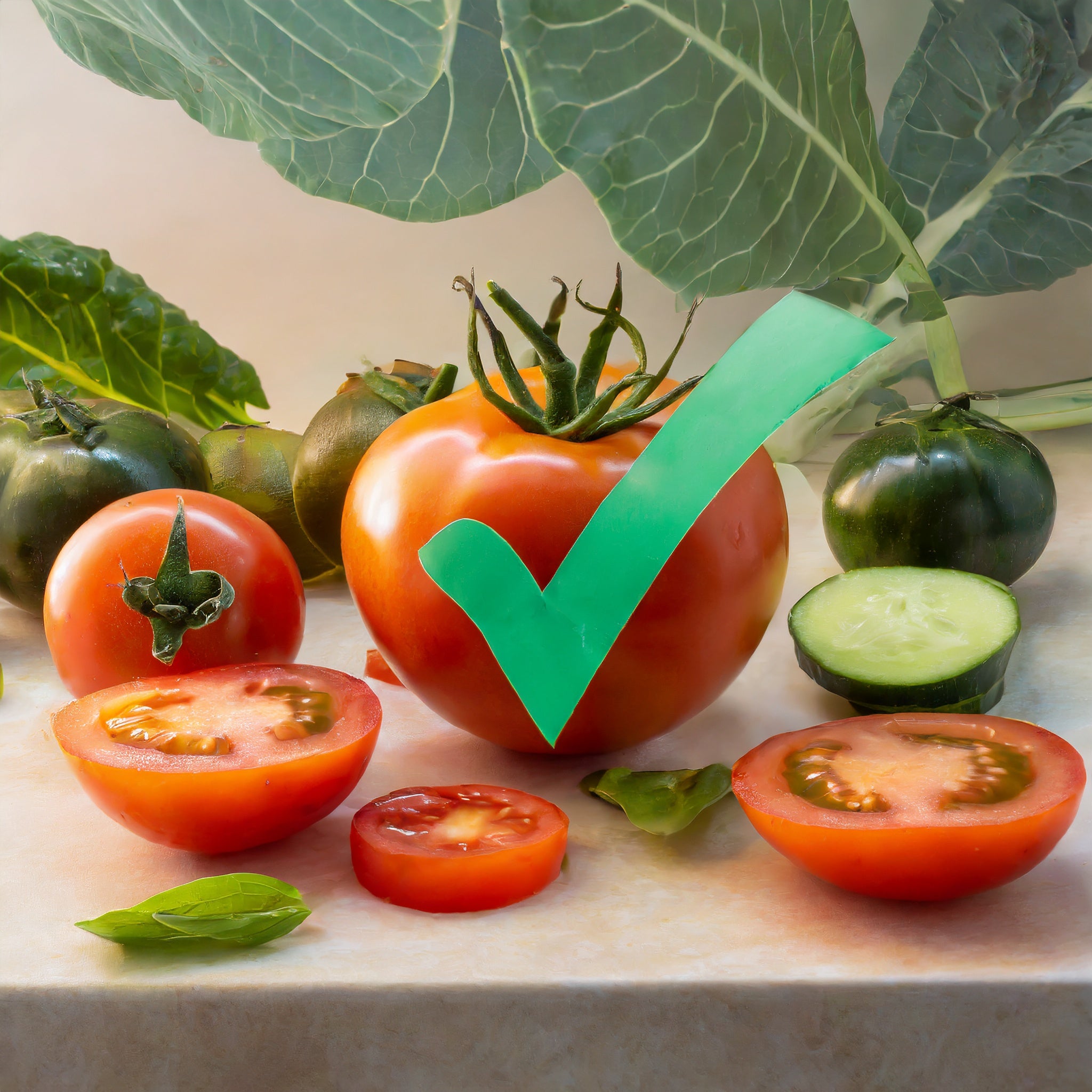Tomatoes can indeed be a part of the meals you prepare, as they're generally low in FODMAPs. However, you'll need to be mindful of the portions and types you use. Fresh, ripe tomatoes are typically safe, while some processed tomato products may be higher in fructose, a potential trigger for those with sensitivities. As you aim to cater to the comfort and health of others, understanding the nuances of tomatoes in a low FODMAP diet is crucial. By keeping informed, you can confidently include this versatile fruit in your recipes, ensuring both deliciousness and digestive peace.
Key Takeaways
- Fresh tomatoes like Common, Truss, Roma, and cherry tomatoes are generally low in FODMAPs.
- Processed tomato products like sun-dried tomatoes and tomato sauce can have higher fructose levels.
- It is important to read labels and look for low FODMAP tomato sauce brands and products.
- Portion control and considering the ripeness of tomatoes are important for staying within low FODMAP limits.
Understanding FODMAPs
To get a handle on FODMAPs, it's essential you understand they're a group of carbohydrates that can cause digestive discomfort in some people. These fermentable oligo-, di-, mono-saccharides, and polyols are present in many foods and can lead to symptoms like bloating, gas, and stomach pain for those with sensitivities, such as individuals with irritable bowel syndrome (IBS).
When it comes to tomatoes, understanding FODMAPs is critical for maintaining a balanced diet without triggering symptoms. Fresh, common, truss, and Roma tomatoes are considered tomatoes low FODMAP when consumed in appropriate serving sizes. Cherry tomatoes also fall into the low FODMAP category, albeit with a smaller threshold for intake.
For those following a low FODMAP tomato diet, it's important to note that while fresh tomatoes are safe in moderation, certain processed tomato products can be problematic. Tomato paste and sun-dried tomatoes, for instance, may harbor higher levels of fructose when consumed in larger servings. Additionally, condiments like ketchup often contain other high FODMAP ingredients. Therefore, reading labels and practicing portion control is key.
Tomato Varieties Explained
Understanding the diversity of tomato varieties is crucial as you navigate the low FODMAP diet. The good news is that fresh tomatoes are low FODMAP, with certain serving sizes in mind. For example, Roma tomatoes are suitable in servings up to 48g, while common tomatoes are low FODMAP at 65g servings. Cherry tomatoes and grape tomatoes are particularly popular for their sweetness and convenience, and you can enjoy these in 45g servings, making them a wonderful addition to your meals.
However, not all tomato products are created equal. Sun-dried tomatoes pack a more concentrated source of fructose, and you'll want to limit your serving to no more than 8g to stay within low FODMAP guidelines. If you're a fan of green tomatoes, they can be low FODMAP in moderation, although specific serving size guidance is less clear.
When it comes to canned products, choose plain canned tomatoes without added onion or garlic, and prefer varieties like Roma or Plum for the lowest FODMAP option. Remember, always read labels carefully, as processed tomato products often contain high FODMAP ingredients that can trigger symptoms.
Fresh Tomatoes and FODMAPs
Regarding fresh tomatoes, you'll find they're low FODMAP when consumed in the appropriate serving sizes. This means that if you're following a low FODMAP diet, you can enjoy fresh tomatoes but should be mindful of how much you consume. For instance, common tomatoes are low FODMAP at servings of 65 grams, and cherry tomatoes at 45 grams according to Monash University's guidelines, a leading authority on FODMAP research. It's essential to note that these serving sizes allow you to manage symptoms while still benefiting from the nutritional value of tomatoes.
When considering whether fresh tomatoes and FODMAPs can coexist in your diet, the answer is yes, but with a caveat: portion control is key. Tomatoes FODMAP Monash research indicates that while tomatoes are low in FODMAPs, exceeding the recommended serving can introduce higher levels of fructans, potentially triggering symptoms.
If you're questioning, "Can you eat tomatoes on FODMAP diet?" the answer is affirmative. Tomato low FODMAP serving sizes are established to ensure you can relish the flavor and health benefits of fresh tomatoes without discomfort. Always aim to stay within these guidelines to maintain a balanced, symptom-free diet.
Tomato Products and Fructose
While fresh tomatoes are low in FODMAPs, you'll find that some processed tomato products, like tomato paste and sun-dried tomatoes, can be high in fructose, especially when consumed in larger quantities. It's crucial to be aware that not all tomato products are created equal when it comes to their FODMAP content.
For instance, sun-dried tomatoes are a concentrated source of fructose, making them potentially problematic for a low FODMAP diet. If you're sensitive to fructose, limiting your intake of sun-dried tomatoes is advisable to avoid symptoms. On the other hand, tomato puree can be considered low FODMAP if you stick to small servings, as validated by FODMAP Friendly and Monash University.
When it comes to tomato sauce, the FODMAP content can vary significantly. Some tomato sauce may be high FODMAP due to added ingredients like onion or garlic, or simply from a higher concentration of tomatoes. To ensure a fodmap tomato sauce remains low FODMAP, opt for those that have been lab-tested and are free from high FODMAP additives, or consider making your own with known low FODMAP ingredients. Remember, serving size is key, so even low FODMAP tomato products should be consumed in moderation.
Reading Labels for FODMAPs
As you navigate the aisles of your local grocery store, it's crucial that you scrutinize ingredient labels to identify high FODMAP additives in tomato products. Understanding the nuances of FODMAP content can be complex, but with careful attention, you can make informed choices that align with your dietary needs.
When selecting a tomato sauce low FODMAP option, check for added ingredients like onion or garlic, which are common culprits for increasing FODMAP levels. Opt for brands that specifically cater to FODMAP restrictions, such as those labeled as low FODMAP tomato sauce brands. These products are typically formulated without high FODMAP components and are safer for those following a strict diet.
Regarding canned tomatoes, FODMAP content can vary. Hunt for canned tomatoes FODMAP compliant, which often means choosing those without added seasonings or sauces. Plain canned Roma or Plum tomatoes usually present the safest bet, as they are less likely to contain additives that could trigger symptoms.
For recipes requiring a concentrated flavor, a fodmap tomato paste that's used within the low FODMAP serving size of 28g can be suitable. Fortunately, some fodmap friendly tomato sauce products have been rigorously tested and certified, providing you with options that minimize the guesswork in meal preparation. Remember, vigilance in reading labels is key to maintaining a balanced, low FODMAP diet.
Portion Sizes Matter
How can you ensure that your tomato intake remains within low FODMAP limits? The answer lies in the precision of portion sizes. Portion sizes matter significantly when it comes to consuming tomatoes on a low FODMAP diet. For instance, Roma tomatoes are considered low FODMAP at servings of 48g, roughly two-thirds of a tomato. Similarly, a portion of 65g of common tomatoes, about half a tomato, is safe for a low FODMAP diet.
When preparing a fodmap tomato sauce recipe or including tomatoes in your meals, measuring out servings is key. Cherry tomatoes are low FODMAP in 45g portions, approximately three tomatoes. Exceeding this amount might introduce moderate to high levels of FODMAPs, which can trigger symptoms for some individuals. Moreover, be mindful that the ripeness of cherry tomatoes can affect their FODMAP content, making it essential to consider both portion sizes and ripeness.
Tomato paste and sauces can be incorporated into your diet, but stick to 13g servings for sauces and 28g for paste to remain on the safe side. If you're wondering, "Can I eat tomatoes on a low FODMAP diet?" the answer is yes, but it's crucial to adhere to recommended serving sizes to maintain a diet that respects your digestive sensitivities.
Low FODMAP Recipe Ideas
You'll find portion control a breeze with these creative low FODMAP tomato recipes that cater to your dietary needs without sacrificing flavor. For a classic dish, try a low FODMAP tomato sauce recipe that's perfect for a satisfying spaghetti dinner. Start with fresh Roma tomatoes, simmer with fresh basil and chives for a robust flavor, and you'll have a from scratch tomato sauce low FODMAP style that rivals any traditional recipe.
If you're craving a hearty bowl of soup, a low FODMAP tomato soup recipe can be easily crafted using canned tomatoes—just ensure they're free of added onion or garlic. Blend with a touch of lactose-free cream and garnish with fresh chives for a comforting meal.
For those needing a low FODMAP pasta sauce without tomatoes, consider using red peppers blended with carrots and a splash of balsamic vinegar to mimic the tangy sweetness of tomatoes. This alternative sauce brings new dimensions to your pasta dishes.
Lastly, a low FODMAP tomato basil sauce can be the perfect accompaniment to grilled chicken or fish. Combine diced tomatoes with fresh basil, a bit of garlic-infused oil, and a sprinkle of salt for a fresh, flavorful topping that respects your dietary restrictions.
Shopping Tips for Tomatoes
When selecting tomatoes for your low FODMAP diet, it's crucial to consider the variety and check for added high FODMAP ingredients. Fresh cherry tomatoes are a safe choice, as they are low in FODMAPs and can add a burst of flavor to your salads and dishes. For cooking, are canned tomatoes low FODMAP? Yes, but ensure they are plain and free from onion or garlic, which are high in FODMAPs.
If you're craving a pasta dish, look for a low FODMAP tomato sauce brand that doesn't include any high FODMAP additives. Be mindful that while sundried tomatoes FODMAP content might be suitable in small servings, they can quickly become high FODMAP if you consume too much. Therefore, it's best to use them sparingly.
For a condiment option, small amounts of low FODMAP tomato sauce, such as ketchup, are acceptable, but always check the label for serving size and additional high FODMAP ingredients. Remember, 13g of ketchup is considered low FODMAP.



Your First 30 Days on Low FODMAP - 5 Tips for Success
Are Grapes Low Fodmap?